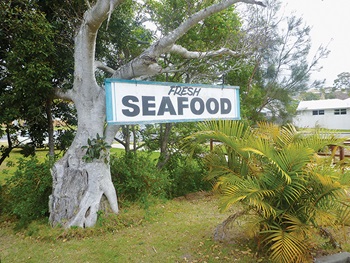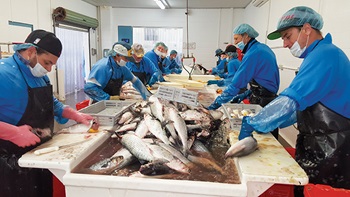Fresh food choices, tourist experiences, local marine knowledge and a sense of belonging are just some of the values local fisheries provide to their communities
 Andrew Nye, Indigenous professional fisher, NSW South Coast
Andrew Nye, Indigenous professional fisher, NSW South Coast Photo: Hayley Egan
Key research findings
 Photo: Michelle Voyer
Photo: Michelle Voyer - Commercial fisheries have a significant ‘multiplier’ effect for regional economies (an additional $1.94 produced for every $1 of fish caught)
- There are high levels of public support for commercial fishing in coastal communities
- Local residents value fresh local fish and will pay a price premium
- Tourists to coastal communities expect fresh local seafood to be part of their
holiday experience
By Anne Crawford
Studies on the professional fishing industry have often concentrated on the profitability of fisheries. Two innovative FRDC-funded projects take a different tack and demonstrate that the benefits of the fishing industry extend well beyond the landed value of the catch.
The first analysis, by researchers at the CSIRO and James Cook University, reveals that Queensland inshore fisheries have a substantial flow-on effect in generating income for regional economies and in benefits to local consumers.
The second study, conducted by the University of Technology in Sydney, shows the importance of wild-catch fishing to the social and economic lives of NSW coastal communities, the value coastal residents place on having a local industry, and the contributions that professional fishers make to their communities.
Understanding such aspects is vital to any consideration of resource management and allocation, the researchers say.
Sean Pascoe, lead author of the Queensland Beyond GVP project, says it quantified the potential economic benefits to regional communities generated by inshore fisheries (pot, net and line fisheries) on Queensland’s east coast, beyond the much-used gross value of production (GVP). It also looked at the industry’s value to consumers.
“The GVP just measures the value of the catch – it doesn’t measure what the importance of that is in terms of local incomes or other business flow-on effects,” Sean Pascoe says.
Lack of information
The three-year study was prompted by frustration within the industry at the lack of understanding of the contribution the sector makes to regional economies and the scarcity of information about this. It comes amid growing concerns about increasing pressure on inshore fisheries as a result of coastal and port development, and the loss of fishing areas due to closures for conservation or recreation activities.
The study was carried out by economists and social scientists from the CSIRO and James Cook University, assisted by Queensland University of Technology research students.
Researchers initially conducted a survey to gather economic data about the industry, which ran alongside another project interviewing 188 fishing operators in key Queensland fisheries. In a second survey they interviewed fishers on the east coast to collect data about what they spent their income on.
Multiplier effect
The researchers then used mathematical modelling to estimate the extended benefits of the industry. “We estimated what’s called the ‘multiplier effect’ that measured the flow-on effect to the regional economy,” Sean Pascoe says.
The study found the estimated average regional ‘multiplier’ was 2.94, meaning that for every dollar of value produced by the fishing industry, an additional $1.94 was generated in the local economy due to fishers’ demand for fuel, gear, supplies and services. Given the fishery GVP of around $46 million in 2012-13, an additional $74 million may have been generated in regional economies.
Another consumer survey found most Queenslanders bought fresh seafood at least once a month and were willing to pay an average 11 per cent more for locally sourced fish, which further added value to the product.
Retail value, and the additional sum gained by consumers and retailers as a result of the product being fresh, pushed the combined economic value of the Queensland inshore commercial fisheries to around $143 million in 2012-13 – more than three times the amount represented by the GVP, although the report cautions that retail estimates were based on limited observational data.
“I was surprised at the magnitude of the effect,” Sean Pascoe says. “Inshore fisheries are relatively small scale – they don’t have a huge value of production – but the value that’s generated back to the local economies in terms of flow-on effects compared to this are substantial.
“The study really highlighted the benefits to the local economies and also to consumers who have access to fresh fish,” he says. “Such information is invaluable when assessing the potential impacts of coastal development resource allocation decisions that may result in the loss of inshore fisheries production.”
A spin-off study by PhD student Samantha Paredes, who worked on this project, will measure how important local fishing is to tourism in coastal areas.
Social contributions
 Local fish suppliers, like the Sydney Fish Market, are tourist drawcards.
Local fish suppliers, like the Sydney Fish Market, are tourist drawcards.Photo: Catherine Norwood
 Processing mullet at Marwell"s Fisheries,Tweed Heads.
Processing mullet at Marwell"s Fisheries,Tweed Heads.
Photo: Richard Brown
Social and Economic Evaluation of NSW Coastal Professional Wild-Catch Fisheries dovetails neatly with the Queensland report, demonstrating too the value-added economic benefits of the state’s industry while looking more broadly at its social contributions.
“Fishers do many things that can’t be estimated in dollars and cents – they’re part of the fabric of rural communities,” says lead researcher Kate Barclay, an associate professor at the University of Technology Sydney (UTS).
She oversaw a collaboration of social scientists and economists from UTS, the University of Wollongong, ENVision Environmental Consulting and the Western Research Institute who, for the first time, developed a multi-faceted picture of the NSW wild-catch fishing industry’s contributions to community wellbeing.
The research involved in-depth interviews of more than 160 people with connections to the industry, an economic survey of NSW fishers, a phone survey of 1400 people to gauge public perceptions of it, and questionnaires and interviews with fish merchants, co-operatives, retailers, wholesalers including the Sydney Fish Market, and tourism operators.
It found that professional fishing and the secondary seafood sector in 2012-13 had a likely direct and indirect output of $436–$501 million and an added value of $215–$248 million. It supported up to 3857 full-time jobs across NSW – of which about 1000 people were working full-time in fishing, with another 403 full-time jobs involved in supplying fishers with goods.
Tourism impacts
“Professional fishing is a vital part of rural communities both economically, in its own right, and through its connections with other sectors,” Kate Barclay says.
Local tourism was one such sector. The survey of the general public found that almost 90 per cent of NSW residents expect to eat local seafood when they visit the coast, with 64 per cent indicating they would be interested in watching professional fishers at work.
Nelson Bay Co-op manager Grahame Lewis said: “People love watching – they come down and watch the boats unload, they see what sort of fish are coming in, they see it getting wheeled over to the shops and they know there’s stuff going in there from the local fishermen. It’s a drawcard really.”
In a telling finding, recreational fishers were significantly more likely to be interested in these aspects of a coastal holiday, challenging assumptions that recreational and professional fishing are in conflict in regional communities.
The professional industry directly supports the recreational sector by providing bait, particularly sardines (pilchards) and School Prawns, accounting for up to a quarter of the $39 million recreational fishers spend on bait and burley annually. Almost 80 per cent of recreational fishers prefer fresh bait even if it is more expensive.
Public support
The study revealed a high level of public support for, and concern about, the local industry. Ninety-six percent of NSW coastal residents indicated the desire to support their local community was a major motivation in buying local product. More than three-quarters were concerned about potential job losses and the loss of identity of NSW fishing towns.
The NSW industry, dominated by small-scale family businesses, has significantly declined over the past 25 to 30 years. In the mid 1980s there were more than 3000 fishing licences in NSW; there are fewer than 1000 now.
“There are very few fishers now who are operating in some historical fishing towns on the NSW coast. Some of them expressed the opinion that their numbers are so low that the support industries are starting to find there’s not quite the critical mass for freight, the co-ops, fuel and so on. If those things fall past a certain point it won’t be viable to fish there any more,” Kate Barclay says.
Professional fishing has provided job opportunities for a wide range of people, including men with limited levels of education and people from diverse cultural backgrounds, such as Italian, Vietnamese and Croatian families who migrated to NSW coastal communities and built businesses in fishing.
It has also been important to Indigenous communities as a source of income and nutritional food, as a way of working “on country” and with natural resources, and for making social connections through sharing fish.
Andrew Nye, an Indigenous professional fisher from the South Coast, said: “There are five generations of fishermen in my family, I’ve been a fisherman since I was 15, it’s always been a part of my life, I just love it. You just blend in, it’s your country, you just feel relaxed and comfortable. I can’t imagine doing anything else. I will die a fisherman.”
Local knowledge
 Fishers haul in mullet on a South West Rock beach.
Fishers haul in mullet on a South West Rock beach. Fishers overwhelmingly learned skills through accumulated knowledge passed down between generations or between mentor and trainee, or by trial and error.
“We talked to some people who said that they’d been fishing in the same areas for 30 or 40 years and can tell you that the species have changed and that some of that’s due to climate change – it’s knowledge that no one else has,” Kate Barclay says.
“That link can be broken. That knowledge about how to fish in that area could be gone in a generation if you didn’t have a wild-catch seafood industry there any more.”
The fishers contribute to society in many ways. They share information about fish movements, weather patterns and the local environment with the wider community, regulators, scientists and recreational fishers; participate in activities such as cleaning up rubbish and rescuing injured wildlife; help maintain public jetties, slipways and ice machines; and donate fish and ice to community events. More than 60 per cent of fishers have taken part in search and rescue operations.
Data gained in the study will be disseminated in informational brochures through fishing co-operatives, local government departments, the NSW Department of Primary Industries and the Sydney Fish Market. Another report on aquaculture, due to be released soon, similarly shows how this industry is closely connected to other sectors in regional areas such as tourism, is an important employer, and that aquaculturists undertake significant environmental stewardship, especially in promoting water quality in estuaries.
Emily Ogier, who manages the FRDC’s Social Sciences and Economics Research Coordination program, says these projects are generating important information for policymakers and regional communities.
“Australian fisheries and aquaculture, like all natural resource-based industries, face pressure from different groups that suggest these industries don’t have a lot of community support,” she says.
“It’s important that the industry has a way to identify – in a relatively easy and replicable way – what it’s giving back to particular regional communities for the use of these resources.
It’s been exciting to see that the novel methods used to tackle the question of how to measure the contributions to community wellbeing were so successful.”
FRDC Research Code: 2014-301, 2013-301
More information
Sean Pascoe, 07 3833 5966,
sean.pascoe@csiro.au
Kate Barclay, 02 9514 1579,
kate.barclay@uts.edu.au





